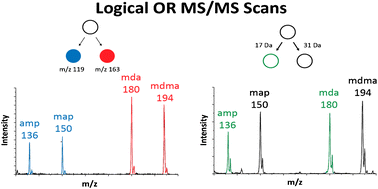Journal of the American Society for Mass Spectrometry ( IF 3.2 ) Pub Date : 2018-03-09 , DOI: 10.1007/s13361-018-1920-3 Dalton T. Snyder 1 , Lucas J. Szalwinski 1 , Robert L. Schrader 1 , Valentina Pirro 1 , Ryan Hilger 1 , R. Graham Cooks 1
Methodology for performing precursor and neutral loss scans in an RF scanning linear quadrupole ion trap is described and compared to the unconventional ac frequency scan technique. In the RF scanning variant, precursor ions are mass selectively excited by a fixed frequency resonance excitation signal at low Mathieu q while the RF amplitude is ramped linearly to pass ions through the point of excitation such that the excited ion’s m/z varies linearly with time. Ironically, a nonlinear ac frequency scan is still required for ejection of the product ions since their frequencies vary nonlinearly with the linearly varying RF amplitude. In the case of the precursor scan, the ejection frequency must be scanned so that it is fixed on a product ion m/z throughout the RF scan, whereas in the neutral loss scan, it must be scanned to maintain a constant mass offset from the excited precursor ions. Both simultaneous and sequential permutation scans are possible; only the former are demonstrated here. The scans described are performed on a variety of samples using different ionization sources: protonated amphetamine ions generated by nanoelectrospray ionization (nESI), explosives ionized by low-temperature plasma (LTP), and chemical warfare agent simulants sampled from a surface and analyzed with swab touch spray (TS). We lastly conclude that the ac frequency scan variant of these MS/MS scans is preferred due to electronic simplicity. In an accompanying manuscript, we thus describe the implementation of orthogonal double resonance precursor and neutral loss scans on the Mini 12 using constant RF voltage.

ᅟ
中文翻译:

RF扫描线性四极杆离子阱中的前体和中性损耗扫描
描述了在RF扫描线性四极离子阱中执行前驱和中性损耗扫描的方法,并将其与非常规ac频率扫描技术进行了比较。在RF扫描变体中,前体离子在低Mathieu q下被固定频率的共振激发信号选择性地激发,同时RF振幅线性倾斜以使离子通过激发点,从而使激发离子的m / z随时间线性变化。具有讽刺意味的是,由于产物离子的频率随线性变化的RF幅度非线性变化,因此仍然需要进行非线性交流频率扫描。在前体扫描的情况下,必须扫描喷射频率,以便将其固定在产物离子m / z上在整个RF扫描中,而在中性损耗扫描中,必须对其进行扫描以保持与被激发的前驱体离子的恒定质量偏移。同时和顺序排列扫描都是可能的。这里只演示前者。所描述的扫描是使用不同电离源对各种样品进行的:由纳米电喷雾电离(nESI)生成的质子化的苯丙胺离子,由低温等离子体(LTP)电离的炸药以及从表面采样并用药签分析的化学战剂模拟物接触喷雾(TS)。我们最后得出结论,由于电子方面的简化,因此首选这些MS / MS扫描的交流频率扫描形式。在随附的手稿中,

ᅟ



























 京公网安备 11010802027423号
京公网安备 11010802027423号